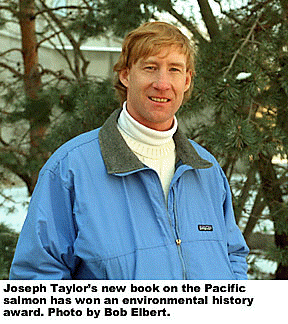Inside Iowa State
February 4, 2000
A fish story
by Steve Sullivan
Fishermen always have stories.
But few are likely to have one
as complicated and controversial as Joseph Taylor's. The
assistant history professor's story is told in his new book,
Making Salmon: An Environmental History of the Northwest
Fisheries Crisis. In March, Taylor will be awarded the
George Perkins Marsh Award by the American Society for
Environmental History for the best book of the year.
 Taylor spent 10 years writing this lively, detailed history
that covers 125 years of Pacific salmon management. Over the
last 20 years, sport and commercial fishing seasons have
evaporated, and salmon runs in the Pacific Northwest now are
protected under the Endangered Species Act. The book is
Taylor's effort to explain how politics, science, industry,
progress and recreation have contributed to the decline of
salmon populations over the last century.
Taylor spent 10 years writing this lively, detailed history
that covers 125 years of Pacific salmon management. Over the
last 20 years, sport and commercial fishing seasons have
evaporated, and salmon runs in the Pacific Northwest now are
protected under the Endangered Species Act. The book is
Taylor's effort to explain how politics, science, industry,
progress and recreation have contributed to the decline of
salmon populations over the last century.
Pacific salmon are born in fresh water and then head to the ocean. As adults, they head back to their natal streams to spawn. The journey and task is so arduous that it kills them.
"Pacific salmon have really amazing life histories that are constantly shaping how people react to them," Taylor said. "It is maddening to engineers and fishery biologists that this fish grows up, spawns once, then dies, which is very unlike Atlantic salmon. It can be a struggle just to understand them."
Pacific salmon have long been harvested by humans for sustenance and profit. They also are an integral part of Northwest culture. Indians consumed hoards of salmon and built mythologies around the fish. European traders moved into the area and exploited the salmon. Northwest settlers increased competition for salmon and consumption of area resources. Both Indians and non-Indians built cultures around catching salmon. Family histories were founded on salmon fishing.
Development in the Northwest not only brought more people, but also logging, mining, farming and other industries that altered land and waterways. Progress was detrimental to the environments in which salmon and peoples had flourished.
Salmon "management" began in the late 1800s as a response to declining runs. Efforts to increase salmon populations involved eliminating natural predators, developing hatcheries, planting fertilized salmon eggs in river beds, and raising salmon in ponds. The rather arrogant belief that humans could create salmon better than nature proved untrue, and salmon populations continued to decline. But that didn't stop scientists, politicians and others from touting the benefits of fish culture.
Over the decades, various interest groups have blamed each other for the plight of salmon. Industrialists blame fisheries. Fishermen blame dams. Everyone blames Indians and other minorities.
"Salmon are infused with a variety of meanings by different people based on where they live and what they do. Indians venerate the fish, while others view them simply as food. Loggers, grazers and irrigators may like salmon, but they also recognize the complications fish cause," Taylor said. "What you get is a cacophony of arguments about how to save salmon and all frame themselves as representing the best interests of the fish."
Just about all the players in Taylor's saga have had the uncanny ability to portray themselves as acting on behalf of salmon, while, simultaneously, watching out for their own interests. Few are left completely off the hook. Taylor is hardest on politicians, though, "for not having the will to make hard decisions" that might not carry much economic benefit, but would help salmon.
As Taylor likes to point out, when you talk about Pacific salmon you are having a political discussion. Reaction to his book upholds this.
"I have been vilified on the Internet by industrialists. I have had very close friends in the fishing community basically cast me out of their circles for criticizing commercial fishers. Angler friends revile me, as well. Environmentalists have accused me of being an apologist for capitalism, and at least one biologist swears that I am loony," Taylor said. "But I also have had people in every one of these interest groups compliment me."
In the late 1970s, Taylor spent 3 1/2 years in college and racked up a .8 grade-point average. In the early 1980s, he left college and spent the rest of the decade fishing, driving a truck and mountain climbing.
"My timing in getting into fishing was really bad," he said. "Salmon runs on the west coast were failing at phenomenally fast rates. The more distressing it became, the more people talked about the issue. As I stepped back from it, I realized everyone was rather confused about the causes and the solutions."
Taylor headed back to school, first to a community college to "rehabilitate my grade-point," then to the University of Oregon for under-graduate and master's work, and the University of Washington for a doctorate. His interest in salmon led to an undergraduate honors thesis on a local fishing community, which grew into Making Salmon.
Taylor's goal is not to point fingers but to illustrate the historical complexity of these issues. His message is that everyone has contributed to the problem and everyone must play a role in the solution.
"A central agenda of mine in the book and in my teaching is to dissuade people from seeking simple answers," Taylor said. "A central element to solving fishery issues has been to tell simple stories and find simple solutions. But simple stories actually perpetuate the problems. I want to make a case for embracing complexity as a necessary element of resolving issues."
Iowa State homepage
Inside Iowa State, inside@iastate.edu,
University Relations Revised
2/2/00
Copyright © 1999, Iowa State University, all rights
reserved
URL:
http://www.inside.iastate.edu/2000/0121/salmon.html